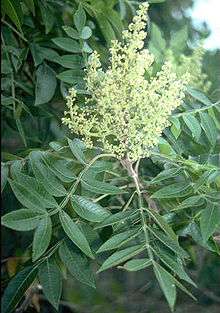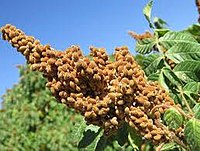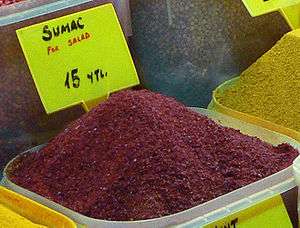Sumac
Sumac (pronounced (/ˈsjuːmæk/) or (/ˈsuːmæk/), and also spelled sumach, sumak, soumak, and sumaq) is any one of about 35 species of flowering plants in the genus Rhus and related genera, in the family Anacardiaceae. It grows in subtropical and temperate regions throughout the world, especially in East Asia, Africa, and North America.[3][4]
| Sumac | |
|---|---|
| Sumac fruit in the autumn season | |
| Scientific classification | |
| Kingdom: | Plantae |
| Clade: | Tracheophytes |
| Clade: | Angiosperms |
| Clade: | Eudicots |
| Clade: | Rosids |
| Order: | Sapindales |
| Family: | Anacardiaceae |
| Subfamily: | Anacardioideae |
| Genus: | Rhus L.[1] |
| Type species | |
| Rhus coriaria | |
| Species | |
|
About 35 species; see text | |
Description
Sumacs are dioecious shrubs and small trees in the family Anacardiadeae that can reach a height of 1–10 m (3.3–32.8 ft). The leaves are usually pinnately compound, though some species have trifoliate or simple leaves. The flowers are in dense panicles or spikes 5–30 cm (2.0–11.8 in) long, each flower very small, greenish, creamy white or red, with five petals. The fruits are reddish, thin-fleshed drupes covered in varying levels of hairs at maturity and form dense clusters at branch tips, sometimes called sumac bobs.
Sumacs propagate both by seed (spread by birds and other animals through their droppings), and by new shoots from rhizomes, forming large clonal colonies.
Taxonomy
The taxonomy of Rhus has a long history, with de Candolle proposing a subgeneric classification in 1825, with five sections. At its largest circumscription, Rhus, with over 250 species, has been the largest genus in the family Anacardiaceae.
Other authors used subgenera and placed some species in separate genera, hence the use of Rhus sensu lato and Rhus sensu stricto (s.s.). One classification uses two subgenera, Rhus (about 10 spp.) and Lobadium (about 25 spp.), while at the same time Cotinus, Duckera, Malosma, Metopium, Searsia and Toxicodendron segregated to create Rhus s.s.. Other genera that have been segregated include Actinocheita and Baronia. As defined, Rhus s.s. appears monophyletic by molecular phylogeny research. However the subgenera do not appear to be monophyletic. The larger subgenus, Lobadium, has been divided further into sections, Lobadium, Terebinthifolia. and Styphonia (two subsections).[5][6][7]
Selected species, by continent
- Asia and southern Europe
- Rhus chinensis Mill. – Chinese sumac
- Rhus coriaria – Tanner's sumac
- Rhus delavayi Franchet
- Australia, Pacific
- Rhus taitensis Guill. (Northeast Australia, Malesia, Micronesia, French Polynesia)
- Rhus sandwicensis A.Gray – neneleau (Hawaii)
- North America
- Rhus aromatica – fragrant sumac
- Rhus copallinum – winged or shining sumac
- Rhus glabra – smooth sumac
- Rhus integrifolia – lemonade sumac
- Rhus kearneyi – Kearney sumac
- Rhus lanceolata – prairie sumac
- †Rhus malloryi Wolfe & Wehr – Ypresian, Washington
- Rhus michauxii – Michaux's sumac
- Rhus microphylla – desert sumac, littleleaf sumac
- Rhus ovata – sugar sumac
- †Rhus republicensis Flynn, DeVore, & Pigg-Ypresian, Washington
- †Rhus rooseae Manchester – Middle Eocene, Oregon
- Rhus trilobata Nutt. – skunkbush sumac
- Rhus typhina – staghorn sumac
- Rhus virens Lindh. ex A.Gray– evergreen sumac
Etymology
The word sumac traces its etymology from Old French sumac (13th century), from Mediaeval Latin sumach, from Arabic summāq (سماق), from Syriac summāq (ܣܡܘܩ)- meaning "red".[8]
- Drupes of a staghorn sumac in Coudersport, Pennsylvania
- A young branch of staghorn sumac
 Winged sumac leaves and flowers
Winged sumac leaves and flowers Rhus hybrid fossil – about 49.5 million years old, Early Ypresian, Klondike Mountain Formation, Washington
Rhus hybrid fossil – about 49.5 million years old, Early Ypresian, Klondike Mountain Formation, Washington Iranian sumac
Iranian sumac
Cultivation and uses

Species including the fragrant sumac (R. aromatica), the littleleaf sumac (R. microphylla), the skunkbush sumac (R. trilobata), the smooth sumac, and the staghorn sumac are grown for ornament, either as the wild types or as cultivars.
Spice and beverage flavoring
The dried fruits of some species are ground to produce a tangy, crimson spice popular in many countries.[9][10] Fruits are also used to make a traditional "pink lemonade" beverage by steeping them in water, straining to remove the hairs that may irritate the mouth or throat, sometimes adding sweeteners such as honey or sugar. Most Rhus species contain only trace amounts of vitamin C and none should be considered a dietary source of this nutrient. In comparative research, the fruits of Rhus coriaria were found to contain the highest levels of ascorbic acid at approximately 39 mg/kg. Sumac’s tart flavor comes from high amounts of malic acid.[11]
The fruits (drupes) of Rhus coriaria are ground into a reddish-purple powder used as a spice in Middle Eastern cuisine to add a tart, lemony taste to salads or meat.[9] In Arab cuisine, it is used as a garnish on meze dishes such as hummus and tashi, it is also commonly added to falafel. Syria uses the spice also, it is one of the main ingredients of Kubah Sumakieh in Aleppo of Syria, it is added to salads in the Levant, as well as being one of the main ingredients in the Palestinian dish musakhan. In Afghan, Armenian, Bangladeshi, Indian, Iranian, Mizrahi, and Pakistani cuisines, sumac is added to rice or kebab. In Armenian, Azerbaijani, Central Asian, Syrian, Jordanian, Lebanese and Turkish cuisines, it is added to salads, kebab and lahmajoun. Rhus coriaria is used in the spice mixture za'atar.[12][13]
In North America, the smooth sumac (R. glabra) and the staghorn sumac (R. typhina) are sometimes used to make a beverage termed "sumac-ade", "Indian lemonade", or "rhus juice". This drink is made by soaking the drupes in cool water, rubbing them to extract the essence, straining the liquid through a cotton cloth, and sweetening it. Native Americans also use the leaves and drupes of the smooth and staghorn sumacs combined with tobacco in traditional smoking mixtures.
Dye and tanning agent
The leaves and bark of most sumac species contain high levels of tannins and have been used in the manufacturing of leather by many cultures around the world. The Hebrew name og ha-bursaka'im means "tanner's sumac". The leaves of certain sumacs yield tannin (mostly pyrogallol-type), a substance used in vegetable tanning. Notable sources include the leaves of R. coriaria, Chinese gall on R. chinensis, and wood and roots of R. pentaphylla. Leather tanned with sumac is flexible, light in weight, and light in color. One type of leather made with sumac tannins is morocco leather.[14]
The dyeing property of sumac needed to be considered when it was shipped as a fine floury substance in sacks as a light cargo accompanying heavy cargoes such as marble. Sumac was especially dangerous to marble: "When sumac dust settles on white marble, the result is not immediately apparent, but if it once becomes wet, or even damp, it becomes a powerful purple dye, which penetrates the marble to an extraordinary depth."[15]
Traditional medicinal use
Sumac was used as a treatment for several different ailments in medieval medicine, primarily in Middle Eastern and South Asian countries (where sumac was more readily available than in Europe). An 11th-century shipwreck off the coast of Rhodes, excavated by archeologists in the 1970s, contained commercial quantities of sumac drupes. These could have been intended for use as medicine, as a culinary spice, or as a dye.[16] A clinical study showed that dietary sumac decreases the blood pressure in patients with hypertension and can be used as disjunctive treatment.[17]
Other uses
Some beekeepers use dried sumac bobs as a source of fuel for their smokers.[18]
Sumac stems also have a soft pith in the center that is easily removed to make them useful in traditional Native American pipemaking. They were commonly used as pipe stems in the northern United States.[19]
Dried sumac wood fluoresces under long-wave ultraviolet radiation.[20]
Toxicity and control
Some species formerly recognized in Rhus, such as poison ivy (Toxicodendron radicans, syn. Rhus toxicodendron), poison oak (Toxicodendron diversilobum, syn. Rhus diversiloba), and poison sumac (Toxicodendron vernix, syn. Rhus vernix), produce the allergen urushiol and can cause severe allergic reactions. Poison sumac may be identified by its white drupes, which are quite different from the red drupes of true Rhus species.
Mowing of sumac is not a good control measure, since the wood is springy, resulting in jagged, sharp-pointed stumps when mown. The plant will quickly recover with new growth after mowing.[21] Goats have long been considered an efficient and quick removal method, as they eat the bark, which helps prevent new shoots. Sumac propagates by rhizome. Small shoots will be found growing near a more mature sumac tree via a shallow running root quite some distance from the primary tree. Thus, root pruning is a means of control without eliminating the plants altogether.
References
- "Rhus L." Germplasm Resources Information Network. United States Department of Agriculture. 2009-11-23. Retrieved 2010-02-09.
- "Rhus L." TROPICOS. Missouri Botanical Garden. Retrieved 2010-02-09.
- 12. Rhus Linnaeus, Flora of China
- Rhus L., USDA PLANTS
- Miller et al 2001.
- Pell 2004.
- Andrés-Hernández & Terrazas 2009.
- "sumac". www.etymonline.com. Retrieved 26 June 2020.
- One may use sumac as a tisane or tea substitute by boiling the dried leaves.Sumac - Ingredients - Taste.com.au
- Poison Sumach and Good Sumac Shrubs
- https://www.researchgate.net/publication/46033244_Comparative_Study_on_the_Chemical_Composition_of_Syrian_Sumac_Rhus_coriaria_L_and_Chinese_Sumac_Rhus_typhina_L_Fruits
- Christine Manfield, Charlie Trotter, Ashley Barber -Spice 2008 - Page 28 "Sumac This reddish ground spice is made from the berries of the sumac bush,"
- Aliza Green Field Guide to Herbs & Spices: How to Identify, Select, and Use ... 2006 - Page 257 "In Lebanon, Syria, and Egypt, sumac is cooked with water to a thick sour paste, which is added to meat and vegetable dishes; this method was also common in Roman times. Sumac appears in the Jordanian spice mixture za'atar (page 288) ..."
- Davis, Charles T. The Manufacture of Leather. Pub: Henry Carey Baird 1885. May be downloaded from: https://archive.org/details/manufactureoflea01davi
- Lee, Arthur (1888). Marble and marble workers: a handbook for architects, artists, masons and students. London: Crosby Lockwood & Son. p. 19.
- Bass, George Fletcher; Allan, James W. (2003). Serçe Limanı: An Eleventh-century Shipwreck. Texas A&M University Press. p. 506. ISBN 978-0-89096-947-2.
- Ardalani, Hamidreza; Moghadam, Maryam Hassanpour; Rahimi, Roja; Soltani, Jalal; Mozayanimonfared, Azadeh; Moradi, Mehdi; Azizi, Ali (2016). "Sumac as a novel adjunctive treatment in hypertension: a randomized, double-blind, placebo-controlled clinical trial". RSC Advances. 6 (14): 11507–11512. doi:10.1039/C5RA22840A.
- Avitabile, Alphonse. Sammataro, Diana. The Beekeeper's Handbook. Publisher: Comstock 1998. ISBN 978-0801485039
- Lewis, Thomas H. The Medicine Men: Oglala Sioux Ceremony and Healing. Publisher: University of Nebraska Press. 1992. ISBN 978-0803279391
- Hoadley, R. Bruce (2000). "Chapter 5: Other Properties of Wood". Understanding Wood: a Craftsman's Guide to Wood Technology (2 ed.). Taunton Press. pp. 105–107. ISBN 978-1-56158-358-4.
- Ortmann, John; Miles, Katherine L.; Stubbendieck, James H.; Schacht, Walter (1997). "Management of Smooth Sumac on Grasslands". University of Nebraska-Lincoln. Cite journal requires
|journal=(help)
Further reading
- RO Moffett. A Revision of Southern African Rhus species FSA (Flora of South Africa) vol 19 (3) Fascicle 1.
- Schmidt, Ernst; Lötter, Mervyn; McCleland, Warren (2002). Trees and Shrubs of Mpumalanga and Kruger National Park. Jacana Media. ISBN 978-1-919777-30-6.
- Andrés-Hernández, A. R.; Terrazas, Teresa (October 2009). "Leaf architecture of Rhus s.str. (Anacardiaceae)". Feddes Repertorium. 120 (5–6): 293–306. doi:10.1002/fedr.200911109.CS1 maint: ref=harv (link)
- Miller, Allison J.; Young, David A.; Wen, Jun (2001). "Phylogeny and Biogeography of Rhus (Anacardiaceae) Based on ITS Sequence Data". International Journal of Plant Sciences. 162 (6): 1401–1407. doi:10.1086/322948.
- Pell, Susan Katherine (May 2004). Molecular systematics of the cashew family (Anacardiaceae) (PDF). Department of Biological Sciences, Louisiana State University. Archived from the original (PhD thesis) on 14 July 2010.CS1 maint: ref=harv (link)
External links
